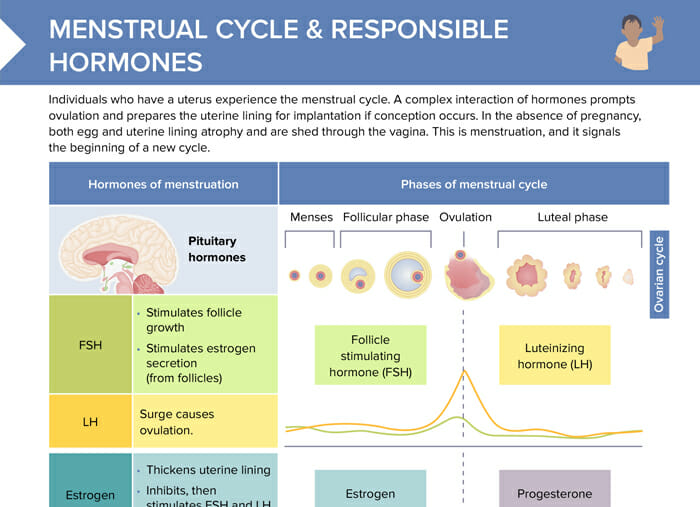What are ovarian hormones?
The primary ovarian hormones are estrogen, progesterone, and small amounts of testosterone.
- Estrogen: responsible for the development and regulation of the female reproductive system; aids in regulating the menstrual cycle
- Progesterone: prepares the uterine lining for pregnancy and helps maintain pregnancy
- Testosterone: helps in libido and bone strength, though in smaller amounts compared to men
These hormones are essential for fertility, menstrual cycles, and overall reproductive health.
What is the menstrual cycle?
The menstrual cycle describes the repeating sequence of events preparing the female reproductive system for a potential birth each month. A complex interaction of hormones prompts ovulation and prepares the uterine lining for implantation if conception occurs. In the absence of pregnancy, both egg and uterine lining atrophy and are shed through the vagina. This is menstruation, and it signals the beginning of a new cycle.
How long is a menstrual cycle?
The length of the menstrual cycle can vary between individuals and over time, but typically ranges from 21 to 35 days for adults, with an average of 28 days.
The phases can roughly be placed in the following time frames:
- Day 1–5: menses
- Day 5–14: follicular phase
- Ovulation
- Day 15–28: luteal phase
Which other hormones are involved in the menstrual cycle?
The pituitary gland releases a number of different hormones, including the following ones that are involved in regulating the menstrual cycle:
- Follicle-stimulating hormone
- Luteinizing hormone
What is the follicle-stimulating hormone (FSH)?
The pituitary hormone FSH stimulates follicle growth and estrogen secretion (from follicles).
What is a normal FSH level to get pregnant?
For women of reproductive age, FSH levels generally range from 4.7 to 21.5 mIU/mL. Lower levels are usually better for fertility. Elevated FSH levels, especially if they are higher than 10 mIU/mL on Day 3 of the menstrual cycle, may indicate reduced ovarian reserve and could be a concern for fertility. However, FSH levels are just one aspect of fertility evaluation; other tests and factors are typically considered.
What is luteinizing hormone (LH)?
LH is secreted by the pituitary gland. A surge of luteinizing hormone causes ovulation.
What is estrogen?
Estrogen, one of the ovarian hormones, thickens the uterine lining and inhibits, then stimulates FSH and LH to trigger ovulation.
What is progesterone?
The ovarian hormone progesterone thickens the uterine lining and inhibits FSH and LH.
Phases of the menstrual cycle
Menses
Estrogen and progesterone are low in this phase. Uterine lining is shed, causing menstruation.
Follicular phase
FSH stimulates follicle growth; rising estrogen thickens the uterine lining.
Ovulation
A surge in LH triggers ovulation.
Luteal phase
LH stimulates the empty follicle to become the corpus luteum, which secretes progesterone, which in turn prepares the uterine lining for a potential pregnancy. If pregnancy doesn’t occur, estrogen and progesterone drop, leading back to the menstrual phase.
The endometrial cycle
The endometrial cycle occurs concurrently with the menstrual cycle and has three main phases:
Menses
Low levels of estrogen and progesterone lead to the shedding of the uterine lining.
Proliferative phase
Estrogen, rising due to follicular development, stimulates the endometrium to thicken and prepare for possible implantation of a fertilized egg.
Secretory phase
Progesterone, produced by the corpus luteum, further prepares the endometrium by making it more glandular and vascular to support a potential pregnancy.
